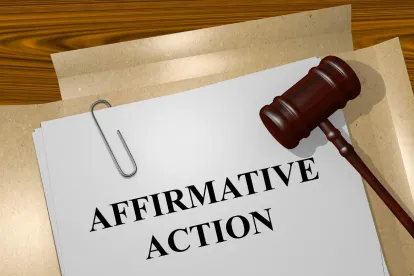At the end of June, the U.S. Supreme Court’s decision in Students for Fair Admissions, Inc. v. President & Fellows Of Harvard College, Nos. 20-1199 & 21-707, 2023 WL 4239254 (U.S. June 29, 2023), outlawed race-based affirmative action in higher education. Splitting along ideological lines, the Court’s conservative supermajority ruled, 6-3, the college admissions programs of Harvard and the University of North Carolina violated the Equal Protection Clause of the Fourteenth Amendment. The monumental decision, which dispensed with 45 years of precedent allowing race-conscious admission policies to achieve a diverse student body, has upended the world of higher education.
But colleges and universities will likely not be the only entities impacted by Students for Fair Admissions. The ruling also raises difficult questions for private employers. While it did not address employers or employment statutes such as Title VII of the 1964 Civil Rights Act, its logic and rationale should put employers on notice that diversity programs in the workplace may no longer be on sure constitutional footing. Chief Justice Roberts wrote in the majority opinion that “[e]liminating racial discrimination means eliminating all of it.” SFFA, 2023 WL 4239254 at *12. That categorical statement leaves little wriggle room for racially conscious initiatives in other contexts.
A Cultural Shift
The Court’s decision in Students for Fair Admissions will affect students today and employees tomorrow. The decision will likely lead to an increased wave of Title VII “reverse discrimination” litigation, opening the door for lower courts—and perhaps eventually the Supreme Court—to reaffirm Title VII’s requirement that race not be considered in employee hiring (and firing).[1] Beyond this, the effects of Students for Fair Admissions will reverberate in the workplace in other ways. The decision is almost certain to spur a cultural shift in employee hiring, the initial wave of which may already be felt.
Chief Justice Roberts’ opinion relied heavily on Grutter v. Bollinger, 539 U.S. 306, 123 S. Ct. 2325, 156 L. Ed. 2d 304 (2003). Grutter held that the Equal Protection Clause did not prohibit the University of Michigan Law School’s narrowly tailored use of race in its admissions process to achieve the compelling interest of the educational benefits resulting from a diverse student body. Grutter also reaffirmed Justice Powell’s opinion announcing the judgment of a splintered Court in Regents of Univ. of California v. Bakke, 438 U.S. 265, 98 S. Ct. 2733, 57 L. Ed. 2d 750 (1978) “as the touchstone for constitutional analysis of race-conscious admissions policies.” See Grutter, 539 U.S. at 323. But Grutter contained one caveat carrying considerable social and cultural implications—a caveat upon which the Chief Justice hung the majority’s hat. Specifically, the Grutter Court perceived affirmative action as a time-limited concept. Justice O’Connor’s majority opinion held that race could be used as a factor in college admissions only so long as it was needed to further the compelling interest of obtaining the education benefits that result from having a diverse student body. Id. at 342–43. As the Grutter Court prophesized, “[w]e expect that 25 years from now, the use of racial preferences will no longer be necessary to further the interest approved today.” Id. at 343.
According to Chief Justice Roberts and the five other Republican-appointed justices, that day has arrived—five years early. As they see it, the “racial preferences” involved in affirmative action are no longer necessary to achieve diversity in schools. The ultimate goal, as the Court conceived it historically, was to arrive at a place where the promises of the Equal Protection Clause could be realized without any regard to race. Declaring racial discrimination “invidious in all contexts,” SFFA, 2023 WL 4239254, at *15, the majority concluded the affirmative action programs at Harvard and UNC (and by implication, countless other institutions) did not satisfy the “strict scrutiny” rubric applicable to race-based classifications. The days of expressly considering race in the pursuit of a more diverse and equitable student population are over.
The Supreme Court’s unabashedly hostile view toward racially conscious policies designed to enhance the inclusion and participation of historically disadvantaged minorities in American life could have significant implications upon hiring. Employers now must pause and consider what the Court’s ruling means for the hiring process. On the day of the ruling, EEOC Commissioner Andrea Lucas penned a piece about Students for Fair Admissions’ impact on the workplace. She observed that: “Poorly structured voluntary diversity programs pose both legal and practical risks for companies. Those risks existed before the Supreme Court’s decision today. Now they may be even higher.”
Although the Court’s opinion did not alter federal employment antidiscrimination laws, they now stand on a more precarious foundation—both socially and legally. The Supreme Court announced America has reached the place where no special consideration should be given to an individual’s race to achieve diversity in higher education. No great leap forward is needed to translate this conclusion to the employment context. As Title VII already requires a colorblind approach to hiring and terminating, employers and employees already inclined to agree with this conclusion now have legal dicta—and a sympathetic Supreme Court—to motivate other courts to follow the strict approach to Title VII analysis, which takes no consideration of a person’s “background circumstances.” As forecasted, this shift could have a major impact on corporate diversity initiatives and talent pipelines.
Paving the Way for Title VII Litigants
Title VI and Title VII are two distinct, though similar, portions of the Civil Rights Act of 1964. Title VI—at issue in Students for Fair Admissions—governs discrimination in higher education. Title VII governs discrimination in employment. Though the case did not directly address Title VII, it may provide a direct on-ramp for Title VII litigants who desire to have a “colorblind” workplace.
Currently, affirmative action plans are only permitted in the workplace in very narrow (and usually remedial) settings. However, race-conscious employee programs are common. Many employers have diversity statements or programs, affinity groups, race-specific mentorship and support programs, special internship or fellowships positions for individuals from diverse backgrounds, and more. These programs have previously been the subject of “reverse discrimination” lawsuits with varying degrees of success. In some jurisdictions, courts have altered the first prong of the prima facie Title VII discrimination claim to require a showing of “background circumstances [that] support the suspicion that the defendant is the unusual employer who discriminated against the majority.” Shea v. Kerry, 961 F. Supp. 2d 17, 31 (D.D.C. 2013), aff’d, 796 F.3d 42 (D.C. Cir. 2015). Other courts require no such showing and engage in a strict analysis of the traditional Title VII elements. See, e.g., Smith v. Lockheed-Martin Corp., 644 F.3d 1321, 1325, n.15 (11th Cir. 2011).
Litigants who believe they are injured by these types of diversity initiatives will no doubt attempt to translate the Court’s colorblind view on the questionable constitutionality of such initiatives from higher education to the workplace. And, unfortunately for the employers that have honed and developed these diversity initiatives, future litigants now have persuasive legal support to bolster their Title VII arguments. In particular, Justice Gorsuch’s concurrence stressed the transferability from Title VI to Title VII. He stated:
If this exposition of Title VI sounds familiar, it should. Just next door, in Title VII, Congress made it unlawful . . . for an employer . . . to discriminate against any individual . . . because of such individual’s race, color, religion, sex, or national origin . . . This Court has long recognized, too, that when Congress uses the same terms in the same statute, we should presume they “have the same meaning.” And that presumption surely makes sense here, for as Justice Stevens recognized years ago, “[b]oth Title VI and Title VII” codify a categorical rule of “individual equality, without regard to race” . . .
But the dissent does not dispute that everything said here about the meaning of Title VI tracks this Court’s precedent . . . interpreting materially identical language in Title VII . . . The words of the Civil Rights Act of 1964 are not like mood rings; they do not change their message from one moment to the next.
Students for Fair Admissions, 2023 WL 4239254, at *51, 56 (Gorsuch, J., concurring) (internal citations omitted).
Between the dicta in Justice Gorsuch’s concurrence and the restrictive colorblind approach required by Chief Justice Roberts’ majority opinion, there is plenty of fodder for future Title VII litigants. And, such litigants may get support from not just the Supreme Court, but from the EEOC. Reflecting on the ruling, EEOC commissioner Andrea Lucas all but adopted Roberts’ colorblind approach for the workplace. “[The EEOC’s mission] is to prevent and eliminate discrimination, not impose ‘equitable’ outcomes,” she said. But at what cost? See SFFA, 2023 WL 4239254, at *95 (Jackson, J., concurring) (“Gulf-sized race-based gaps exist with respect to the health, wealth, and well-being of American citizens.”). Time will tell.
FOOTNOTES
[1] Notably, Title VII already requires a colorblind approach to employee hiring and termination. See, e.g., Smith v. Lockheed-Martin Corp., 644 F.3d 1321, 1325, n.15 (11th Cir. 2011). Despite this, lower courts are split on how strictly this requirement is applied. Thus, Title VII claims have resulted in varying results.





 />i
/>i
